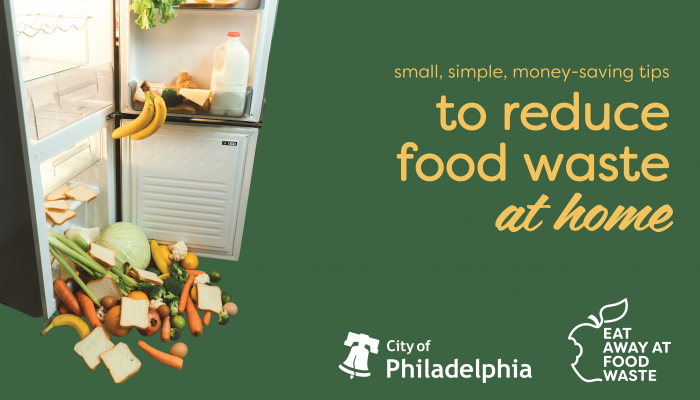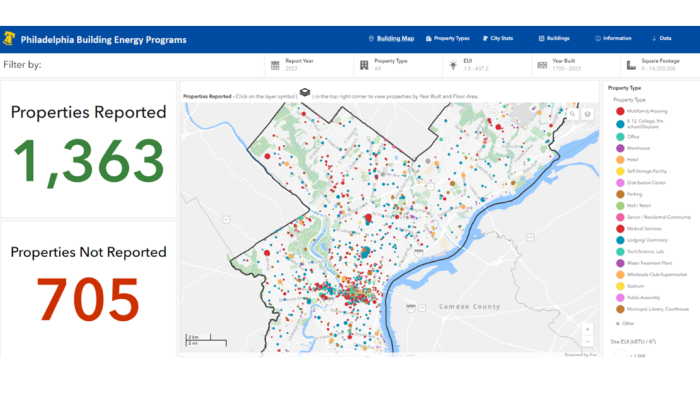With a bit of planning and preparation, you can stop food waste before it happens. Remember: know before you go, stow, and throw.
Know before you go
Before you go to the grocery store, know what you need, make a meal plan, and make a list to avoid buying too much.
- What you have: Did you check your pantry, fridge, and freezer before making a shopping list? You might already have the foods you need on hand, or can swap ingredients in your recipe to use up what you have.
- What you need: Do you have a plan to eat everything on your shopping list? Double-check your recipe to see how many servings it makes, and when you get to the store, check serving sizes on food packaging.
- What you buy: Did you make a shopping list? Making a list can prevent buying too much or the wrong items when you get to the store. Download a printable meal planner and shopping list.
Quick tip! A Philly family spends up to $1,300 each year on wasted food. You can use up what you already have in your fridge & cabinets and still enjoy delicious new recipes by swapping similar ingredients (did you know applesauce can be substituted for oil in most baking recipes?)
Know before you stow
Make sure you know how to store foods to extend their life by freezing, portioning, and organizing.
- Stowing: How you store your food can affect how long it will stay fresh. You can extend the life of even the most delicate greens and herbs by storing them wrapped in a damp cloth inside a container in the refrigerator. Download a cheat sheet for storing produce to extend its life.
- Freezing: If you aren’t sure if you’ll be able to use up a food item before it spoils, freeze it! Freezing pauses the clock on your food’s lifespan, and freezing foods like bread, meats, and produce to keep them fresh for months. Just don’t forget to use it up! Download a cheat sheet for freezing food & cooking it up later.
- Portioning: Portion foods in smaller containers or bags before storing to make cooking easier and keep track of how many meals you can prepare.
- Organizing: Treat your kitchen like a restaurant and use the first-in, first-out rule. Use up last week’s groceries first, and store older items in front of new ones in your pantry so you’ll be more likely to use them.
Quick tip! Do you “lose” food items in the back of your cabinet or in the depths of your freezer? Keep a list in your kitchen – in a spot that’s easy to remember, like stuck onto the fridge door – of items you need to eat up or share with a neighbor before they spoil. Never lose a loaf of bread to freezer burn again!
Know before you throw
It helps to know strategies and recipes for using leftovers, pantry foods, and fruits and veggies past their peak freshness.
- Re-use: Even wilted greens and stale bread can have a second life at your table. Here are some of our favorite ways to revive & reuse foods that are past their peak.
- Crisp up wilted greens, floppy carrots, and other should-be crunchy veggies in ice-cold water for 5-10 minutes
- Toss wilted greens into stews, soups, and smoothies
- Make pickles from leftover cucumbers, carrots, onions, radishes, and more.
- Cut bruises or other unappealing pieces from fresh fruits and veggies, and eat the rest! Or, toss cut up fruits – bruises and all – into smoothies and juices (be sure to cut off spoiled or rotten pieces)
- Dry out bread, then crush and season to make homemade breadcrumbs
- Keep vegetable scraps, hard cheese rinds, and bones stored in a bag in the freezer, then boil to make homemade soup stock
- Re-plate: Do you often have a fridge full of leftovers at the end of the week? Take a break from cooking and plan a smorgasbord dinner and let everyone in your family choose their favorite food from the fridge to eat.
- Re-fresh: Refresh leftovers by adding a side of fresh veggies, stewing grilled meats in a spicy sauce, or broiling pasta and casseroles with a fresh topping of cheese.
Quick tip! Many foods have a purpose beyond your plate. Use cut lemons in homemade household cleaners, dried herbs and spices to keep pests away, and coffee grounds to fertilize house plants or your garden.
How to manage food waste at home
Preventing food waste is not always possible. When you are able, these are steps you can take to reduce the amount of food waste sent to the landfill.
The main ways to manage food waste in Philadelphia are:
- Donate it. Residents and households can donate packaged, shelf-stable foods.
- Compost it. Residents and households can compost at home, at a Community Compost Network or other neighborhood food scrap drop-off site, or with a private food scrap pick-up subscription.
- Use your in-sink garbage disposal. Residents and households are encouraged to use their garbage disposal to manage grindable food waste. Learn how below.
Learn where you can donate and compost food in Philadelphia.
Garbage disposal tips
If you have an in-sink garbage disposal in your home, you can use it to grind spoiled foods and food scraps instead of throwing them in the trash. All food sent down your drain is processed at the Philadelphia Water Department’s treatment facility and turned into energy and compost.
Quick tip: Don’t ever put hard items (like seeds and pits) or grease or fat down the drain.
Learn other dos and don’ts of using your in-sink garbage disposal.




